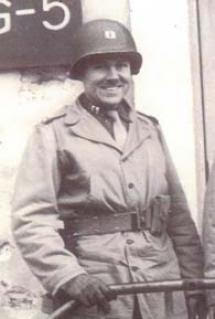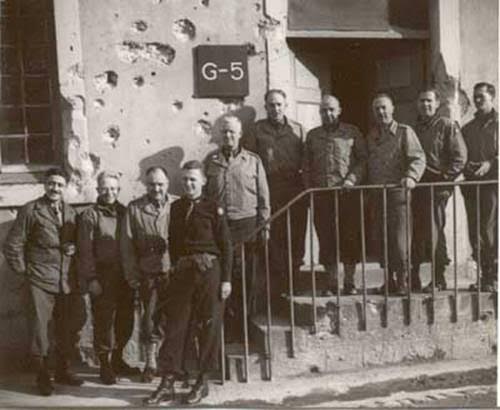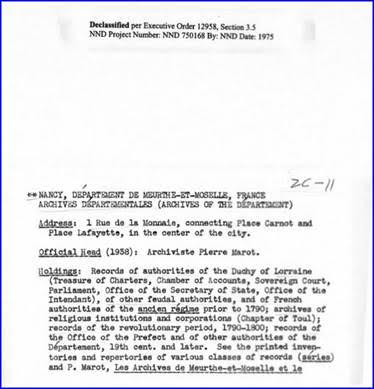actualités
Monuments Men en Lorraine !
14 octobre 1944
le Captain Robert K. Posey, un « Monument Man » de la 3rd US Army visitait l’église de Vézelise !
Un
nouveau grand coup de chapeau à notre ami Edouard Renière de Bruxelles
qui à l’occasion de l’une de ses recherches a découvert ce compte rendu
de la visite de l’église de Vézelise le 14 octobre 1944 par le
Capitaine Robert K. Posey.
Edouard
qui a aussitôt fait des recherches supplémentaires pour en savoir plus
sur cet officier, architecte, qui a séjourné et œuvré à Nancy, a rédigé
un petit guide sur les principales richesses culturelles de la ville,
et qui par la suite a retrouvé une quantité d’œuvres d’art, dont de
nombreuses pièces exceptionnelles, pillées par les nazis.
The Monuments Men
Back to The Monuments Men | Posey, Maj. Robert K.
Robert Kelley Posey ( 1904-1977 )
 Robert
Kelley Posey was born in Morris, Alabama on April 5, 1904. He attended
Alabama Polytechnic Institute (today known as Auburn University) on a
scholarship from the Reserve Officer Training Corps (ROTC). He
graduated with a B.S. in Architectural Engineering in 1926, and a B.S.
in Architecture in 1927. While in the ROTC, he was commissioned in the
U.S. Army Reserves as a second lieutenant.
Robert
Kelley Posey was born in Morris, Alabama on April 5, 1904. He attended
Alabama Polytechnic Institute (today known as Auburn University) on a
scholarship from the Reserve Officer Training Corps (ROTC). He
graduated with a B.S. in Architectural Engineering in 1926, and a B.S.
in Architecture in 1927. While in the ROTC, he was commissioned in the
U.S. Army Reserves as a second lieutenant.
He
was also a student activist involved in demonstrations against Huey
Long, Fascism, and the Ku Klux Klan. After graduation, he worked at the
architectural firm Miller, Martin & Lewis in Birmingham, Alabama.
He then moved to New York and enrolled in the Beaux-Arts Institute of
Design, where he earned a certificate in architectural design in 1932.
Posey
received orders from the U.S. Army Reserves in 1942 and, after
extensive training, worked with the U.S. Army Corps of Engineers
building airstrips in the town of Churchill, in northern Canada. In
March 1944 he was assigned to the Civil Affairs Center in Shrivenham, England for training at the Civil Affairs Training School. Soon after, he was assigned as Monuments Officer for General George S. Patton’s U.S. Third Army. Arriving in Normandy, France within a month of D-Day, he was one of the first Monuments Men in the field. As
U.S. Third Army made its way through France, Posey inspected historic
monuments and made temporary repairs, prevented damage by American
troops by posting Off Limits notices, and made contact with local art
specialists. In the early days of his assignment, he was solely
responsible for the large region of France including Saint-Lô,
Coutances, Saint-Malo, Les Iffs, and Rennes.
In
January 1945 Posey was assigned an assistant, Monuments Man Pfc.
Lincoln Kirstein. Together, they inspected the eastern, more remote
towns of France before U.S. Third Army’s advance into Germany via
Luxembourg in early spring 1945. During their
time in the French city of Nancy, Posey noticed a natural curiosity in
the occupying American troops toward the charming city. He wrote and
distributed a brief history of Nancy which included basic information
on nearby monuments of cultural importance. The American
troops were grateful for the cultural diversion, and Posey was later
inspired to write similar handbooks for the cities of Metz, France and
Trier, Germany.
Posey and Kirstein were involved in some of the most notable discoveries of the MFAA. In
late February 1945 the pair discovered a rare wall painting of
the Annunciation dating from the fourteenth century at the
Priory Church of Mont Saint-Martin in Lorraine, France.
The painting had been concealed by layers of plaster for centuries
until a combination of bomb damage and rain had caused the layers to
peel away. In the city of Trier, Posey came down with a horrible
toothache. Townspeople led Posey and Kirstein to a local dentist, who
pulled the tooth. Before they left, however, the dentist suggested they
visit his son-in-law, who had been an art scholar before the war. In a
remote cottage, the son admitted that he had once worked closely with
Reichsmarschall Hermann Göring and Alfred Rosenberg, leader of the
Einsatzstab Reichsleiter Rosenberg (ERR, the Nazi looting agency tasked
by Hitler to assemble works of art for his planned Führermuseum at
Linz, Austria). The scholar then proceeded to reveal priceless
information that would eventually lead to the discovery of the vast
salt mine in Altaussee, Austria in May 1945.
The discovery of the Altaussee salt mine was a turning point for the MFAA.
Posey and Kirstein arrived in the Austrian town on May 16, 1945 to find
that the principal mine entrance had been blocked by strategically
detonated bombs. While locals predicted it would take two weeks to
clear a path through the rubble, Posey used his architectural training
to clear a path by the following morning. Lantern in hand, Posey
was the first Monuments Man to enter the mine, followed closely by
Kirstein. Hidden inside miles of tunnels and hollowed-out caverns, the
ERR had hidden masterpieces including Michelangelo’s Bruges
Madonna, Vermeer’s The Astronomer, the Ghent
Altarpiece by
Jan van Eyck, and thousands of other works of art and culturally
significant items looted from the great French collections by the
ERR.These
masterpieces were later evacuated to the Munich Central Collecting
Point by a team of Monuments Men led by Lt. Cdr. George Stout and
eventually returned to the countries from which they had been stolen.
For
his remarkable service with the MFAA, Posey was named a Chevalier of
the French Legion of Honor and Chevalier of the Order of Leopold by the
Belgian government. Some of his memories from his MFAA service were
published in an article for College Art Journal entitled
“Protection of Cultural Materials During Combat” (1946). Upon his
return to the United States, he resumed his career as an architect. In
1946 he began a nearly three-decade career at the architectural firm
Skidmore, Owings & Merrill in New York
City. As a senior associate, he worked on many well-known projects,
including the Union Carbide Building and the Lever House in New York
City, and the Sears Tower in Chicago. He was a member of the American
Institute of Architects, the American Society of the French Legion of
Honor, and held offices in numerous social clubs in Westchester County,
New York. He retired in 1974 after a long and successful career as a
respected architect.
(1946). Upon his
return to the United States, he resumed his career as an architect. In
1946 he began a nearly three-decade career at the architectural firm
Skidmore, Owings & Merrill in New York
City. As a senior associate, he worked on many well-known projects,
including the Union Carbide Building and the Lever House in New York
City, and the Sears Tower in Chicago. He was a member of the American
Institute of Architects, the American Society of the French Legion of
Honor, and held offices in numerous social clubs in Westchester County,
New York. He retired in 1974 after a long and successful career as a
respected architect.
Robert
Posey died in White Plains, New York on April 18, 1977. In appreciation
for his role in returning the Ghent Altarpiece, the Belgian
Government sent a bouquet of flowers.
http://www.monumentsmenfoundation.org/the-heroes/the-monuments-men/posey-capt.-robert-k.
Précision
apportée par Edouard : “ D’après le livre « The
Monuments Men », c’est Robert Posey, caserné à Nancy, qui a
inventorié là de même qu’à Metz, et à d’autres endroits en Alsace et en Lorraine. »

Par chance, une seconde photo, provenant d’un autre fonds, permet de localiser l’endroit où a été prise
la photo du Cpt Robert K. Posey : à Nancy !
Le compte rendu de la visite de l’église de Vézelise
par le Captain Robert K. Posey le 14 octobre 1944NARA
M1944. Records of the American Commission for the Protection and
Salvage of Artistic and Historic Monuments in War Areas, 1943-1946. http://www.fold3.com/image/270355278

La fiche du Cpt Posey présentant les Archives départementales de Meurthe-et-Moselle
https://www.fold3.com/image/270356469
|


En février 1945, le Captain Robert K. Posey et le Pfc Lincoln Kirstein
découvraient la fresque de l’Annonciation dans l’église de Mont-Saint-Martin (photo : Wikpédia)
|
 Robert
Kelley Posey was born in Morris, Alabama on April 5, 1904. He attended
Alabama Polytechnic Institute (today known as Auburn University) on a
scholarship from the Reserve Officer Training Corps (ROTC). He
graduated with a B.S. in Architectural Engineering in 1926, and a B.S.
in Architecture in 1927. While in the ROTC, he was commissioned in the
U.S. Army Reserves as a second lieutenant.
Robert
Kelley Posey was born in Morris, Alabama on April 5, 1904. He attended
Alabama Polytechnic Institute (today known as Auburn University) on a
scholarship from the Reserve Officer Training Corps (ROTC). He
graduated with a B.S. in Architectural Engineering in 1926, and a B.S.
in Architecture in 1927. While in the ROTC, he was commissioned in the
U.S. Army Reserves as a second lieutenant. (1946). Upon his
return to the United States, he resumed his career as an architect. In
1946 he began a nearly three-decade career at the architectural firm
Skidmore, Owings & Merrill in New York
City. As a senior associate, he worked on many well-known projects,
including the Union Carbide Building and the Lever House in New York
City, and the Sears Tower in Chicago. He was a member of the American
Institute of Architects, the American Society of the French Legion of
Honor, and held offices in numerous social clubs in Westchester County,
New York. He retired in 1974 after a long and successful career as a
respected architect.
(1946). Upon his
return to the United States, he resumed his career as an architect. In
1946 he began a nearly three-decade career at the architectural firm
Skidmore, Owings & Merrill in New York
City. As a senior associate, he worked on many well-known projects,
including the Union Carbide Building and the Lever House in New York
City, and the Sears Tower in Chicago. He was a member of the American
Institute of Architects, the American Society of the French Legion of
Honor, and held offices in numerous social clubs in Westchester County,
New York. He retired in 1974 after a long and successful career as a
respected architect.


